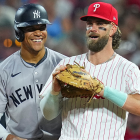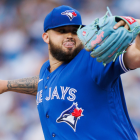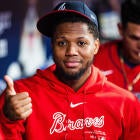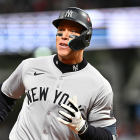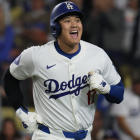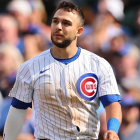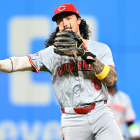The 2019-20 MLB free-agent class was shaken up ever so slightly this past weekend. The Yankees acquired impending free agent Edwin Encarnacion, a player whose free-agent stock was already on the rise, and dropped him into their home run happy ballpark. Encarnacion is having a strong age 36 season and will get to showcase himself with a contender the rest of the year.
It didn't take him very long to make an impact for his new team:
"I don't feel pressure. I just try to have fun. That's what it's all about," Encarnacion told reporters, including Howie Kussoy of the New York Post, after hitting his first home run as a Yankee on Tuesday. "… It's pretty great. You feel better when you win."
Given his age, Encarnacion is firmly in the "one-year contract only" phase of his career, but a strong showing with the Yankees could land him a larger guaranteed salary earlier in the offseason, so he doesn't have to wait around like so many other veteran free agents. For an impending free agent looking for his first World Series ring, the trade was a perfect fit for Encarnacion.
Here are our 2019-20 MLB Free Agent Power Rankings for June, and here are two impending free agents who are on the rise, and two others who are seeing their stock slip this year.
Stock Up
For the first time since his fluky dirt bike-related shoulder injury, there are signs Madison Bumgarner is getting back to his old self. He's pitched to a 3.19 ERA with a .241/.302/.393 opponent's batting line in his last five starts and 31 innings, and that includes starts against the Braves, Dodgers, and Brewers.
(Yes, that is the "get it out of the ocean" game.)
More important than the raw numbers, Bumgarner's velocity is ticking up, and so too is his strikeout rate. His velocity dipped noticeably following the shoulder injury two years ago and it could just be that he needed that much time to get over it. Bumgarner may not have been hurt, necessarily, but he might not have been 100 percent physically either.
Here are Bumgarner's month-by-month four-seam fastball and cut fastball average velocity readings:
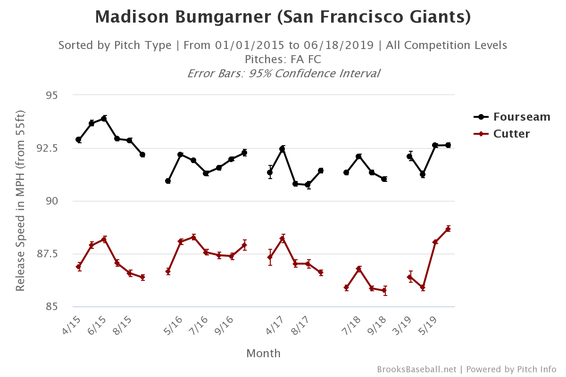
Thanks in part to the increased velocity, Bumgarner's strikeout rate (23.6 percent) is his highest since 2016, and his swing-and-miss rate (11.6 percent) is his highest since 2015. Last year Bumgarner put up a 19.8 percent strikeout rate with a 9.2 percent swing-and-miss rate, numbers comfortably below the MLB averages (22.8 percent and 11.1 percent, respectively).
Of course velocity is not everything. It is one piece of the pie, like spin rate and location and tunneling. That does not mean velocity is insignificant, however. Given the strikeout and swing-and-miss rates, Bumgarner at 92-93 mph is a different animal than Bumgarner at 90-91 mph, especially when he bust righties inside with a cutter that is more upper-80s than mid-80s.
Bumgarner will turn 30 on August 1 and, given his career workload, it is unlikely he will revert back to the no-doubt ace he was from 2011-16. That doesn't mean he is done as an effective big-league starter. Far from it. Bumgarner still has the tools, especially now after regaining velocity, to be an above-average contributor, and that's better than most.
First things first: Is Bumgarner getting traded at the deadline? That comes before free agency. There are two scenarios here:
- Bumgarner is traded. The qualifying offer is taken out of play and he would presumably be more likely to test free agency. Think Jon Lester in 2014. That is especially true if Bumgarner goes to a contender and pitches well.
- Bumgarner is not traded. The Giants would likely pursue an extension to keep him in their uniform the rest of his career. Considering the team's place in the standings, maintaining that relationship is the only reason to keep him.
Bumgarner is a full year older than Patrick Corbin, who doesn't have nearly as good a track record, yet landed a six-year deal worth $140 million last offseason. That would seem to bode well for Bumgarner. Corbin had a far better contract year, however, plus his slider is legitimately one of the five best pitches in the game. He was dominant more recently going into free agency.
My hunch is Bumgarner's next contract will be shocking. Shockingly big or shockingly small? I'm not quite sure. Even with the velocity uptick, I don't think Bumgarner is a $200 million pitcher, especially in this market. I don't think $100 million is out of the question given his reputation, and if the velocity holds strong and he keeps missing bats, the better his chances at nine figures.
At the same time, Bumgarner getting Dallas Keucheled feels like a legitimate possibility. He holds out for top dollar given his track record and no team wants to pay it, so he winds up settling for a much smaller than expected contract next March or April. Right now, I think Bumgarner signs over the winter, and he winds up with $20 million annually across 4-5 years, with an opt-out.
The Yandy Diaz trade has been getting a lot of attention and understandably so, but Diaz was not the only shrewd lineup addition the Rays made over the winter. They also inked veteran Avisail Garcia to a one-year, $3.5 million contract after he was non-tendered by the White Sox. He's rewarded them with a .290/.343/.476 batting line and 11 homers through 63 games.
We have over 2,500 plate appearances telling us Garcia is not actually this good. He came into 2019 as a career .271/.321/.420 hitter, which is about as close to league average as it gets. Not great, not terrible, just average. This year though, there is some reason to believe Garcia's improvement is legitimate. For starters, he is squaring the ball up much more often:
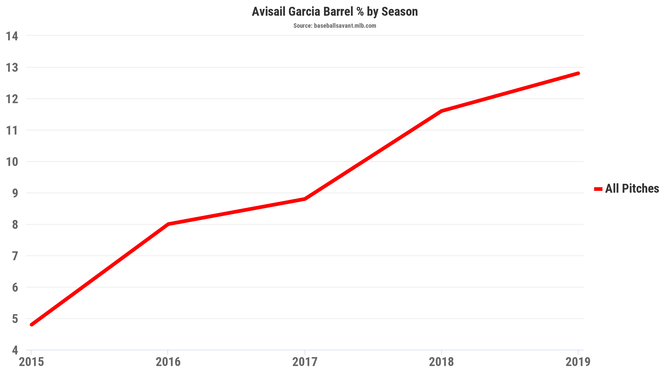
In a nutshell, a "barrel" is how Statcast defines the best possible combination of exit velocity and launch angle. Those are the batted balls that tend to do the most damage, and Garcia is barreling up the ball more and more with each passing season. It is not a surprise his .284 expected batting average and .512 expected slugging percentage are in the top 20 percent of the league.
There's also this: Garcia is 28 years old. He turned 28 last week. Garcia has been around so long that it can be easy to forget how young he is. A player putting together his most productive season at this age is a perfectly normal baseball thing. Add in some strong speed and defense metrics ...
- Sprint speed: 28.6 feet per second (88th percentile)
- Outs above average: +4 (89th percentile)
... and you have a sneaky well-rounded player, even if Garcia doesn't walk as much as you'd like (6.3 percent) and chases out of the zone a little too often (37.4 percent). A flawed player? Sure. A player who is a net positive to this team? Absolutely.
A strong season for a contending team will improve any free agent's stock. Garcia also has age on his side -- whichever team signs him would be buying the best years of his career, in theory -- and that's a huge selling point. He's likely thinking Jay Bruce money (three years, $39 million). In this market, I'd consider two years and $20 million, and another chance at free agency at age 30, a nice get for Garcia. Anything more is gravy.
Stock Down
I'm not sure Welington Castillo's two-year, $15 million contract could be going any worse for the White Sox. Granted, it's not like he's sunk their 2018-19 seasons and single-handedly taken taken them out of the contention, but this is pretty bad:
- .235/.298/.390 batting line in 302 plate appearances.
- Baseball Prospectus rates his defense at 12.9 runs below average.
- Served an 80-game performance-enhancing drug suspension last year.
The White Sox placed Castillo on the injured list with an oblique strain earlier this week, and called up top prospect Zack Collins to fill the roster spot. Should Collins perform well, it is entirely possible the ChiSox will stick with him behind the plate the rest of the season and move on from Castillo. The club is emphasizing youth whenever possible.
Castillo, 32, was never a gifted defender, but his bat made up for it earlier in his career. That is no longer the case. A catcher who doesn't hit or catch isn't worth a roster spot. Castillo's track record might land him a non-roster invite to spring training next year -- catching is always in demand -- though I think we've reached the point where his days as a no-doubt big leaguer are over. When a guy like Martin Maldonado struggles to find work like last winter, this version of Castillo is out of luck.
One year ago Jhoulys Chacin was the unlikely ace of an upstart Brewers team that went to Game 7 of the NLCS. This year Chacin, 31, has been one of the least effective -- and most home run prone -- pitchers in baseball. He is sitting on a 5.60 ERA through 13 starts and 62 2/3 innings, and the underlying numbers are not good.
| K% | BB% | GB% | HR/9 | HR/FB | Hard-Hit Rate | |
|---|---|---|---|---|---|---|
2017 | 20.0% | 9.4% | 49.1% | 0.95 | 11.4% | 28.2% |
2018 | 19.6% | 8.9% | 42.2% | 0.84 | 9.3% | 37.3% |
2019 | 18.1% | 11.4% | 34.4% | 1.72 | 15.8% | 40.5% |
To be fair, pretty much every pitcher is giving up more home runs this season. In Chacin's case, his 0.88 increase in HR/9 is the eighth largest in baseball, and his 14.7 percentage point decrease in ground ball rate since 2017 is the second largest. More fly balls have always equaled more home runs, and that has never been more true than right now, in the launch angle era.
There is a bit of a chicken or the egg thing going on with Chacin's rates. Is he striking out fewer batters and issuing more walks because the home runs are scaring him out of the strike zone? Or are his home runs up because he's striking out fewer batters (more contact allowed) and issuing more walks (more hitter's counts)? I lean toward the latter.
Either way, Chacin is a sinker/slider guy who isn't getting ground balls and is on the wrong side of 30. That is not a good place to be heading into free agency. There will always be a need for innings eaters, so it's not like Chacin will be forced into retirement. But building on last year and turning it into a nice multi-year contract? That's pretty much out the window at this point.
As recently as 2016, Chacin had to sign a minor league contract. In 2017, he landed a one-year deal worth $1.8 million. I think he can beat that this winter, though not by much. Another two-year, $15.5 million contract like his current deal seems out of the question right now. There are simply too many red flags and negative trends.

















